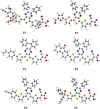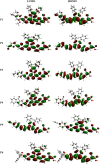DFT and TD-DFT calculation of new thienopyrazine-based small molecules for organic solar cells
- PMID: 27843488
- PMCID: PMC5084391
- DOI: 10.1186/s13065-016-0216-6
DFT and TD-DFT calculation of new thienopyrazine-based small molecules for organic solar cells
Abstract
Background: Novel six organic donor-π-acceptor molecules (D-π-A) used for Bulk Heterojunction organic solar cells (BHJ), based on thienopyrazine were studied by density functional theory (DFT) and time-dependent DFT (TD-DFT) approaches, to shed light on how the π-conjugation order influence the performance of the solar cells. The electron acceptor group was 2-cyanoacrylic for all compounds, whereas the electron donor unit was varied and the influence was investigated.
Methods: The TD-DFT method, combined with a hybrid exchange-correlation functional using the Coulomb-attenuating method (CAM-B3LYP) in conjunction with a polarizable continuum model of salvation (PCM) together with a 6-31G(d,p) basis set, was used to predict the excitation energies, the absorption and the emission spectra of all molecules.
Results: The trend of the calculated HOMO-LUMO gaps nicely compares with the spectral data. In addition, the estimated values of the open-circuit photovoltage (Voc) for these compounds were presented in two cases/PC60BM and/PC71BM.
Conclusion: The study of structural, electronics and optical properties for these compounds could help to design more efficient functional photovoltaic organic materials.
Keywords: Optoelectronic properties; Organic solar cells; TD-DFT; Thienopyrazine derivatives; Voc (open circuit voltage); π-conjugated molecules.
Figures






Similar articles
-
Theoretical investigation of new thiazolothiazole-based D-π-A organic dyes for efficient dye-sensitized solar cell.Spectrochim Acta A Mol Biomol Spectrosc. 2014 Apr 24;124:646-54. doi: 10.1016/j.saa.2014.01.052. Epub 2014 Jan 23. Spectrochim Acta A Mol Biomol Spectrosc. 2014. PMID: 24513712
-
Studies of New 2,7-Carbazole (CB) Based Donor-Acceptor-Donor (D-A-D) Monomers as Possible Electron Donors in Polymer Solar Cells by DFT and TD-DFT Methods.ChemistryOpen. 2022 Feb;11(2):e202100273. doi: 10.1002/open.202100273. ChemistryOpen. 2022. PMID: 35103407 Free PMC article.
-
Molecular design of D-π-A-π-D small molecule donor materials with narrow energy gap for organic solar cells applications.J Mol Model. 2023 Aug 5;29(9):273. doi: 10.1007/s00894-023-05680-8. J Mol Model. 2023. PMID: 37542668
-
Review on the DFT computation of bulk heterojunction and dye-sensitized organic solar cell properties.J Mol Model. 2025 Feb 13;31(3):83. doi: 10.1007/s00894-025-06304-z. J Mol Model. 2025. PMID: 39945938 Review.
-
Theoretical studies of optoelectronic and photovoltaic properties of D-A polymer monomers by Density Functional Theory (DFT).Des Monomers Polym. 2021 Jul 27;24(1):224-237. doi: 10.1080/15685551.2021.1956209. eCollection 2021. Des Monomers Polym. 2021. PMID: 34366700 Free PMC article. Review.
Cited by
-
Synthesis and Characterization of Polyimide with High Blackness and Low Thermal Expansion by Introducing 3,6-bis(thiophen-2-yl)diketopyrrolopyrrole-Based Chromophores.Polymers (Basel). 2024 Nov 29;16(23):3365. doi: 10.3390/polym16233365. Polymers (Basel). 2024. PMID: 39684111 Free PMC article.
-
DFT and TD-DFT studies for optoelectronic properties of coumarin based donor-π-acceptor (D-π-A) dyes: applications in dye-sensitized solar cells (DSSCS).Heliyon. 2021 Nov 9;7(11):e08339. doi: 10.1016/j.heliyon.2021.e08339. eCollection 2021 Nov. Heliyon. 2021. PMID: 34816038 Free PMC article.
-
A model to study the inhibition of nsP2B-nsP3 protease of dengue virus with imidazole, oxazole, triazole thiadiazole, and thiazolidine based scaffolds.Heliyon. 2019 Aug 1;5(8):e02124. doi: 10.1016/j.heliyon.2019.e02124. eCollection 2019 Aug. Heliyon. 2019. PMID: 31406937 Free PMC article.
-
1,2,4-Triazine-based Materials: Spectroscopic Investigation, DFT, NBO, and TD-DFT Calculations as Well As Dye-sensitized Solar Cells Applications.J Fluoresc. 2022 Nov;32(6):2053-2063. doi: 10.1007/s10895-022-03005-1. Epub 2022 Jul 21. J Fluoresc. 2022. PMID: 35861897 Free PMC article.
-
Novel Fluorescent Benzothiazolyl-Coumarin Hybrids as Anti-SARS-COVID-2 Agents Supported by Molecular Docking Studies: Design, Synthesis, X-ray Crystal Structures, DFT, and TD-DFT/PCM Calculations.ACS Omega. 2023 May 23;8(22):19587-19602. doi: 10.1021/acsomega.3c01085. eCollection 2023 Jun 6. ACS Omega. 2023. PMID: 37284548 Free PMC article.
References
-
- Sariciftci NS, Heeger AJ, Nalwa HS. Handbook of organic conductive molecules and polymers. New York: Wiley; 1997. p. 414.
-
- Chen HY, Hou J, Zhang S, Liang Y, Yang G, Yang Y, Li G. Polymer solar cells with enhanced open-circuit voltage and efficiency. Nat Photonics. 2009;3(11):649–653. doi: 10.1038/nphoton.2009.192. - DOI
-
- Hoppe H, Sariciftci NS. Morphology of polymer/fullerene bulk heterojunction solar cells. J Mater Chem. 2006;16(1):45–61. doi: 10.1039/B510618B. - DOI
-
- Helgesen M, Søndergaard R, Krebs FC. Advanced materials and processes for polymer solar cell devices. J Mater Chem. 2010;20(1):36–60. doi: 10.1039/B913168J. - DOI
-
- Park SH, Roy A, Beaupre S, Cho S, Coates N, Moon JS, Heeger AJ. Bulk heterojunction solar cells with internal quantum efficiency approaching 100 and percent. Nat Photonics. 2009;3(5):297–302. doi: 10.1038/nphoton.2009.69. - DOI
LinkOut - more resources
Full Text Sources
Other Literature Sources
Research Materials
Miscellaneous

